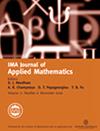Identifying a response parameter in a model of brain tumor evolution under therapy
IF 1.4
4区 数学
Q2 MATHEMATICS, APPLIED
引用次数: 1
Abstract
A nonlinear conjugate gradient method is derived for the inverse problem of identifying a treatment parameter in a nonlinear model of reaction-diffusion type corresponding to the evolution of brain tumors under therapy. The treatment parameter is reconstructed from additional information about the tumour taken at a fixed instance of time. Well-posedness of the direct problems used in the iterative method is outlined as well as uniqueness of a solution to the inverse problem. Moreover, the parameter identification is recast as the minimization of a Tikhonov type functional and the existence of a minimizer to this functional is shown. Finite difference discretization of the space and time derivatives are employed for the numerical implementation. Numerical simulations on full 3-dimensional brain data is included showing that information about a spacewise dependent treatment parameter can be recovered in a stable way.确定治疗下脑肿瘤进化模型中的反应参数
针对脑肿瘤治疗过程中反应扩散型非线性模型中治疗参数的反演问题,导出了一种非线性共轭梯度法。治疗参数是根据在固定时间实例中获取的关于肿瘤的附加信息重建的。概述了迭代法中使用的直接问题的适定性以及反问题解的唯一性。此外,参数辨识被重新定义为Tikhonov型泛函的最小化,并证明了该泛函的最小化存在性。采用空间导数和时间导数的有限差分离散化方法进行数值实现。对全三维脑数据进行了数值模拟,结果表明,空间相关治疗参数的信息可以稳定地恢复。
本文章由计算机程序翻译,如有差异,请以英文原文为准。
求助全文
约1分钟内获得全文
求助全文
来源期刊
CiteScore
2.30
自引率
8.30%
发文量
32
审稿时长
24 months
期刊介绍:
The IMA Journal of Applied Mathematics is a direct successor of the Journal of the Institute of Mathematics and its Applications which was started in 1965. It is an interdisciplinary journal that publishes research on mathematics arising in the physical sciences and engineering as well as suitable articles in the life sciences, social sciences, and finance. Submissions should address interesting and challenging mathematical problems arising in applications. A good balance between the development of the application(s) and the analysis is expected. Papers that either use established methods to address solved problems or that present analysis in the absence of applications will not be considered.
The journal welcomes submissions in many research areas. Examples are: continuum mechanics materials science and elasticity, including boundary layer theory, combustion, complex flows and soft matter, electrohydrodynamics and magnetohydrodynamics, geophysical flows, granular flows, interfacial and free surface flows, vortex dynamics; elasticity theory; linear and nonlinear wave propagation, nonlinear optics and photonics; inverse problems; applied dynamical systems and nonlinear systems; mathematical physics; stochastic differential equations and stochastic dynamics; network science; industrial applications.

 求助内容:
求助内容: 应助结果提醒方式:
应助结果提醒方式:


